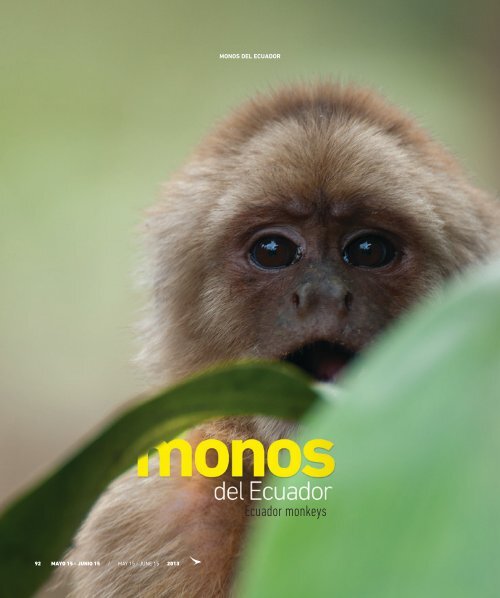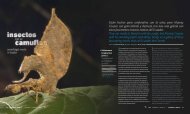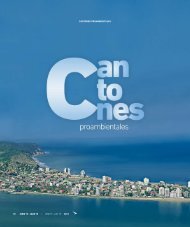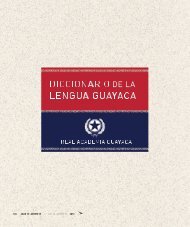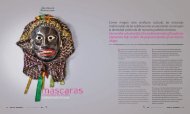Create successful ePaper yourself
Turn your PDF publications into a flip-book with our unique Google optimized e-Paper software.
MONOS DEL ECUADOR<br />
<strong>Ecuador</strong> monkeys<br />
92 MAYO 15 - JUNIO 15 / MAY 15 - JUNE 15 2013
Contemple algunos de los más curiosos y atractivos primates<br />
que habitan en el Oriente <strong>ec</strong>uatoriano, presentados a través<br />
de la intrépida cámara de Murray Cooper.<br />
See some of the most curious primates that inhabit the<br />
<strong>Ecuador</strong>ian Amazon, presented through the fearless camera of<br />
Murray Cooper.<br />
Texto / text: ABORDO_fotografía / photography: Murray Cooper<br />
Foto de apertura:<br />
Capuchino de frente<br />
blanca / White-fronted<br />
capuchin monkey<br />
˜Cebus albifrons˜<br />
Selva tropical baja /<br />
Lowland tropical forest<br />
Habita en los bosques<br />
tropicales y subtropicales<br />
s<strong>ec</strong>os de <strong>Ecuador</strong>, Brasil,<br />
Colombia y Perú. Los machos<br />
alcanzan hasta 80 mm y las<br />
hembras hasta 87. Vive en lo<br />
alto de los árboles. /<br />
Inhabits the tropical and<br />
subtropical forests of <strong>Ecuador</strong>,<br />
Brazil, Colombia and Peru.<br />
The males reach up to 80 mm<br />
and the females up to 87 mm.<br />
They live high in trees.<br />
Son ágiles, perspicaces, y cuando se acostumbran a la<br />
presencia humana, curiosos y divertidos. Los primates<br />
que viven en el <strong>Ecuador</strong> son extremadamente diversos.<br />
La mayoría viven en el sotobosque o dosel de los bosques<br />
tropicales de la Amazonía. Es por ello que, <strong>com</strong>o admite<br />
Murray Cooper, no es muy fácil conseguir una buena toma<br />
de ellos: “Los monos tienen un hábitat muy amplio, y por<br />
ende, podría pasar mucho tiempo hasta que se acerquen<br />
a donde n<strong>ec</strong>esitas. ¡Para capturar las fotos presentadas<br />
aquí se requirió de semanas de paciencia!”<br />
El Parque Nacional Yasuní tiene –en este ámbito tambiénla<br />
diversidad más alta de primates en el mundo, y es un<br />
excelente lugar para observarlos. Esp<strong>ec</strong>íficamente, la<br />
Estación de Investigación Tiputini de la Universidad de<br />
San Francisco ofr<strong>ec</strong>e una interesante infraestructura<br />
-según Murray Cooper- para aproximarse a ellos, gracias<br />
al sistema de torres y puentes aéreos que posee, además<br />
de que en dicha zona no ha habido cacería, y <strong>com</strong>o<br />
resultado no son tan tímidos. También se sugiere acudir a<br />
algún <strong>ec</strong>olodge para desde allí esperar el momento ideal y<br />
observar sus gráciles movimientos.<br />
Por mucho tiempo y hasta ahora, los primates han sido<br />
una fuente de <strong>com</strong>ida para los pueblos nativos de la<br />
Amazonía, por lo cual es difícil lograr que se relajen<br />
en nuestra presencia. En todo caso, el lente experto de<br />
Murray Cooper nos permite aproximarnos a estos monos<br />
que habitan en nuestro territorio y que dan cuenta de la<br />
riqueza faunística de nuestro país.<br />
Monkeys are agile, savvy, and when they get used to<br />
the presence of humans, they are curious and fun. The<br />
primates that live in <strong>Ecuador</strong> are extremely diverse. The<br />
majority live in the undergrowth and canopy of the tropical<br />
forests of the Amazon. Thus, as Murray Cooper says, it is<br />
not easy to photograph them: “Their range is large, so it<br />
can take a good while until they are in the vicinity of the<br />
tower. These photos are many weeks of waiting!”<br />
Yasuni National Park has the highest primate diversity in<br />
the world and is an excellent place to observe monkeys.<br />
Sp<strong>ec</strong>ifically, the Tiputini Research Station of San Francisco<br />
University is one of the best places for primates, thanks<br />
to its incredible system of towers and canopy walkways,<br />
and there has not been any hunting in the area for a long<br />
time, so they are not skittish. It is also suggested to visit<br />
some <strong>ec</strong>olodge, and from there, wait for the ideal time to<br />
observe their graceful movements.<br />
Unfortunately, these primates have been a prime food<br />
source of the indigenous nations of the Amazon for<br />
millennia, so they are seldom relaxed in our presence.<br />
Regardless, the expert lens of Murray Cooper allows us<br />
to better understand these monkeys, which live in our<br />
territory and are proof of the wealth of fauna throughout<br />
the country.<br />
2013 MAY 15 - JUNE 15 / MAYO 15 - JUNIO 15 93
Murray Cooper<br />
murraycooperphoto.<strong>com</strong><br />
R<strong>ec</strong>onocido fotógrafo conservacionista de<br />
nacionalidad sudafricana. Reside actualmente<br />
en <strong>Ecuador</strong>. R<strong>ec</strong>orre el país fotografiando la<br />
vida silvestre. Ha publicado algunos de sus<br />
mejores trabajos en importantes revistas <strong>com</strong>o<br />
National Geographic. Es además coautor de los<br />
libros Colibríes de <strong>Ecuador</strong> y Aves en Colombia,<br />
y co-propietario de Worldwildzoom, empresa<br />
<strong>ec</strong>uatoriana que produce aplicaciones para iPad<br />
relacionadas con su trabajo fotográfico. /<br />
R<strong>ec</strong>ognized conservationist photographer from<br />
South Africa. He currently lives in <strong>Ecuador</strong>. Murray<br />
tours the country photographing wildlife. He<br />
has published some of his works in important<br />
magazines, such as National Geographic, in<br />
addition to being the co-author of books on<br />
Hummingbirds of <strong>Ecuador</strong> and Birds of Colombia,<br />
and is the co-owner of Worldwildzoom, an<br />
<strong>Ecuador</strong>ian <strong>com</strong>pany that produces iPad<br />
applications related to his photographic works.<br />
Mono lanudo gris o churuco<br />
Brown woolly monkey<br />
˜Lagothrix lagotricha˜<br />
Selva tropical baja / Lowland Rainforest<br />
Esta esp<strong>ec</strong>ie habita en grupos de entre 10 y 45<br />
individuos. Sin embargo, los grupos que rebuscan<br />
<strong>com</strong>ida normalmente son de dos a seis individuos<br />
que se apartan <strong>del</strong> grupo principal. /<br />
This sp<strong>ec</strong>ies lives in groups ranging from 10-45<br />
individuals. Foraging groups, however, tend to consist<br />
of 2-6 individuals, which branch off from the main<br />
group into different trees.<br />
Tití o socayo rojo<br />
Dusky titi monkey<br />
˜Callicebus cupreus˜<br />
Selva tropical baja / Lowland Rainforest<br />
Viven en familias monógamas de 2 a 5 individuos,<br />
prefiere el sotobosque de los bosques de várzea. /<br />
They live in monogamous family groups of 2 to 5<br />
individuals, prefer Varzea flooded forest, middle<br />
strata of forest.<br />
94 MAYO 15 - JUNIO 15 / MAY 15 - JUNE 15 2013
Saki cabelludo /<br />
Saki Monkey<br />
˜Pith<strong>ec</strong>ia monachus˜<br />
Mono ardilla /<br />
Common squirrel<br />
monkey<br />
˜Saimiri sciureus˜<br />
Selva tropical baja / Lowland Rainforest<br />
Este primate endémico de Sudamérica puede<br />
llegar a medir casi 50 cm tomando en cuenta la<br />
cola. Posee un pelaje negro y enredado./<br />
This primate, endemic to South America, can<br />
measure 50 cm. (20 inches), taking into account<br />
its tail. This monkey has a black, nappy coat.<br />
Selva tropical baja / Lowland Rainforest<br />
Puede vivir en todo tipo <strong>del</strong> bosque, se los<br />
encuentra en las lagunas Agapo. Vive en el<br />
sotobosque de la selva./<br />
Utilizes all forest types, but is the sp<strong>ec</strong>ies that<br />
most utilizes Agapo (Black water) lagoons. They<br />
live in middle and lower strata of forest.<br />
Tamarino de<br />
manto negro/<br />
Rio Napo Tamarin<br />
monkey<br />
˜Saguinus graellsi˜<br />
Bosque tropical /<br />
Tropical forest<br />
Habita en el trópico y<br />
subtrópico nororiental. Viven<br />
en grupos de entre 2 a 9<br />
individuos./<br />
Lives in tropical and<br />
subtropical forests located in<br />
northeastern <strong>Ecuador</strong>, This<br />
monkey lives in groups ranging<br />
from 2 to 9 individuals.<br />
96 MAYO 15 - JUNIO 15 / MAY 15 - JUNE 15 2013
MONOS DEL ECUADOR<br />
Capuchino de frente blanca /<br />
White-fronted capuchin monkey<br />
˜ Cebus albifrons ˜<br />
Selva tropical baja / Lowland tropical forest<br />
De color café a excepción en su vientre y rostro, este mono<br />
endémico de sudamérica se encuentra tanto en la Costa <strong>com</strong>o<br />
en el Oriente <strong>ec</strong>uatoriano. /<br />
Brown in color, except on its belly and face, this monkey makes<br />
South America its home, living on both the coast and in the<br />
Amazon.<br />
Mono aullador <strong>ec</strong>uatoriano /<br />
Red-Mantled Howler Monkey<br />
˜Alouatta palliata aequatorialis˜<br />
Selva tropical / Lowland Rainforest<br />
Se trata de una subesp<strong>ec</strong>ie <strong>del</strong> mono aullador cuyo hábitat se<br />
extiende desde Panamá hasta Perú. Están en peligro de extinción<br />
y son considerados vulnerables debido a la pérdida de hábitat y<br />
la caza furtiva. /<br />
This is a subsp<strong>ec</strong>ies of the howler monkey that inhabits regions<br />
running form Panama in the north to Peru in the south. This<br />
sp<strong>ec</strong>ies is endangered and considered vulnerable, due to a<br />
shrinking habitat and poaching.<br />
98 MAYO 15 - JUNIO 15 / MAY 15 - JUNE 15 2013
Mono nocturno vociferante /<br />
Night monkey<br />
˜Aotus vociferans ˜<br />
Bosque tropical / Lowland Tropical Forest<br />
El único primate nocturno en la Amazonía<br />
<strong>ec</strong>uatoriana. Viven en familias monógamas de 2 a 6<br />
individuos, y habitan en el sotobosque. /<br />
The only nocturnal primate in <strong>Ecuador</strong>ian Amazon.<br />
Monogamous family groups of 2 to 6 individuals, all<br />
forest types, middle strata of forest.<br />
Mono capuchino de cara blanca /<br />
White-faced Capuchin monkey<br />
˜Cebus capucinus˜<br />
Lowland tropical and sub-tropical forest /<br />
Bosque tropical y subtropical<br />
Viven en grupos familiares de entre 2 a 24 individuos.<br />
En <strong>Ecuador</strong> habita en los bosques tropicales y<br />
subtropicales. Se alimenta de frutos maduros y<br />
ciertos artrópodos. /<br />
Lives in families ranging from 2 to 24 individuals. In<br />
<strong>Ecuador</strong>, it inhabits tropical and subtropical forests.<br />
This monkey eats ripe fruits and certain anthropoids.<br />
100 MAYO 15 - JUNIO 15 / MAY 15 - JUNE 15 2013


